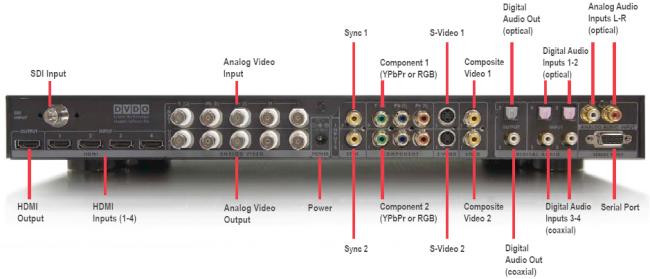How it Works
A scaling engine works best when the target display device has disabled
its own internal scaler, or at least limited it to a minimum. This mode is
called Native Rate, and achieving it is a primary goal for any scaler user.
The VP30, in Advanced mode (the difference from the regular user mode is
the addition of new extended menus and options) could not make this
operation any more painless. The UI is crisp, graphical, and intuitive.
You get full access to every timing option one can imagine, from DVI output
timing to RGBHV sync polarities.
Each input has its own memory bank of settings like contrast, brightness,
color, tint, etc. More advanced settings like sharpness work different for
each
input (component input behaves differently than composite input). The
infamous CUE bug (the
Chroma Upsampling Error, or Chroma Bug) can be filtered nicely on a per-input basis, without some
of the artifacts that this can cause with other processors
(cross color suppression causing red flickering on thin red menus, and the macroblocking bug).
One slightly under-emphasized feature is the Y/C delay, which has been in
the iScan processors since the iScan HD. The VP30 increases the resolution
of this feature dramatically - to near perfection.
The VP30 also adds an excellent scaling algorithm, and brings it up to 10 bit
processing. This doesn't sound like much of an improvement on paper, but in
reality, I noticed a much clearer, smoother film-like image, and it is really
a step up from the iScan HD and HD+.
There is no shortage of analog inputs or outputs on the unit. The new design
finally adds five BNC connectors for RGBHV input/output, instead of the VGA/D15
output that users have long been complaining about. Two component inputs
also double as RGBcvS inputs for European users, and there are also two composite and S-Video
connections.

On most inputs, the picture quality (PQ) remains on par with the iScan HD+, I did notice
significantly better results on the S-Video and composite inputs with regards
to prior versions of this processor.
But, as we all know, digital inputs are what "all the kids are doing
nowadays". The iScan VP30 provides an HDMI output, and four (!!) HDMI inputs.
For CRT users and old timers like me, an SDI input is also available.
The HDMI inputs ate whatever porridge I gave them – from 480p and 576p, to more
esoteric formats like 1080i50 and 720p50. The SDI input was a bit less
forgiving and did have some minor glitches with a KeyDigital Panasonic RP56
(my old workhorse). I'm fairly unique in this perspective, as most users are
not having any problems with SDI on the VP30.
Video processor users are quite pedant about features they need, and they
need a lot. In particular, the projector crowd often requires a picture
stretched in very specific ways, and in particular areas of the screen, due to
screen and lens usage. The iScan VP30 delivers more than anyone could wish
for, including image placement, masking, standard aspect ratios, custom aspect
ratios, zooming, cropping, and shifting. If anything, I found that adjustment
of all these parameters tended to be a bit confusing due to too many options
(something I scarcely complain about).
I was really after a potentially
easier solution where I could just put a cross on the top left corner and
then drag it over to where I wanted on the other corner, and then just move
everything around.
Click Here to Go to Part III.